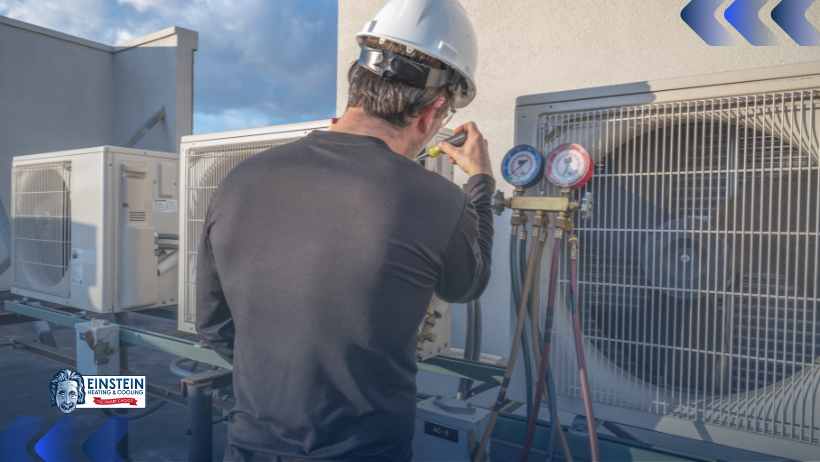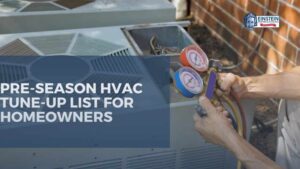Mini-split systems have gained immense popularity for their efficiency and flexibility in heating and cooling spaces. Prope mini-split sizing is crucial to ensure optimal performance and energy efficiency. In this guide, we’ll delve into the key factors that influence mini-split sizing in your Arizona home to help you make informed decisions.
1. Importance of Accurate Mini Split Sizing
Mini-split sizing is a critical aspect of HVAC system design, as it directly affects the system’s ability to maintain a comfortable indoor environment. An oversized or undersized mini-split can lead to inefficiencies, increased energy consumption, and discomfort. Let’s explore the factors contributing to the sizing of a mini-split system, also known as ductless air conditioner.
Room Size and Load Calculation
The size of the space you intend to heat or cool is a fundamental factor in mini-split sizing. Conducting a load calculation helps determine the heating or cooling capacity required to maintain the desired temperature. Factors such as square footage, insulation, window size, and occupancy play a crucial role in this calculation.
Climate and Temperature Variations
The local climate and temperature variations influence the mini-split sizing requirements. Areas with extreme temperatures, whether hot or cold, may require larger capacity systems to handle the additional workload. Understanding the climate conditions will aid in selecting a mini-split that can effectively handle the heating or cooling demands of the environment.
2. Mini-split Efficiency Ratings
Efficiency ratings are essential considerations when sizing a mini-split system, as they impact energy consumption and operational costs. Evaluating the following efficiency factors will guide you in selecting an energy-efficient mini-split.
Seasonal Energy Efficiency Ratio (SEER)
SEER is a measure of cooling efficiency over a season, representing the ratio of cooling output to energy input. Higher SEER ratings indicate better energy efficiency, making it a key parameter to consider when sizing a mini-split for cooling requirements.
Heating Seasonal Performance Factor (HSPF)
For heating efficiency, the HSPF rating is crucial. It measures the heating efficiency of a mini-split system over a season. A higher HSPF rating signifies better heating performance, ensuring efficient operation during colder months.
3. Insulation and Air Leakage
The insulation levels and air leakage of a building significantly impact the load calculation for mini-split sizing. Insufficient insulation or high air leakage can result in increased heat gain or loss, requiring a larger capacity mini-split to compensate. Consider getting a professional HVAC maintenance regularly to check on these factors.
Insulation Quality
Evaluate the insulation quality of walls, ceilings, and floors. Well-insulated spaces will have lower heat transfer rates, reducing the workload on the mini-split system. Ensure that the insulation meets or exceeds local building codes for optimal energy efficiency.
Air Leakage Assessment
Perform an air leakage assessment to identify and seal any gaps or cracks in the building envelope. Minimizing air leakage helps maintain a stable indoor temperature and reduces the overall load on the mini-split system, contributing to energy savings.
4. Window Type and Placement
Windows plays a significant role in determining the heat gain or loss within a space. Proper consideration of window type, size, and placement is essential for accurate mini-split sizing.
Window Size and Material
Larger windows allow more sunlight to enter, increasing heat gain during hot seasons. Choose windows with appropriate glazing to control heat transfer. Energy-efficient windows with low-emissivity coatings can help reduce the impact on mini-split sizing.
Window Orientation
The orientation of windows relative to the sun’s path influences the amount of solar radiation entering a room. South-facing windows receive more sunlight than north-facing ones. Understanding window orientation aids in sizing a mini-split system that can effectively manage the additional heat load.
5. Occupancy and Equipment Heat Generation
The number of occupants in space and the heat generated by electronic equipment contribute to the overall load on a mini-split system. Considering these factors is crucial for accurate sizing and maintaining a comfortable indoor environment.
Occupancy Levels
Checking for the correct mini-split size can be difficult. Higher occupancy levels result in increased body heat and exhalation, affecting the indoor temperature. Sizing a mini-split based on the expected occupancy ensures that the system can handle the additional heat load generated by people in the space.
Electronic Equipment Heat
Electronics such as computers, printers, and appliances generate heat. Evaluate the heat output of electronic equipment in the designated space to determine the additional load on the mini-split system. Proper sizing accounts for both human occupancy and equipment-generated heat.
6. Zoning and Multiple Indoor Units
Zoning allows for customized temperature control in different areas of a building, impacting the sizing requirements for mini-split systems. Additionally, installing multiple indoor units connected to a single outdoor unit requires careful consideration of each zone’s load.
Zoning Considerations
Divide the building into zones based on usage patterns and occupancy. Zoning enables individual temperature control, optimizing energy usage and reducing the load on the mini-split system. Consider the load requirements for each zone when sizing the system.
Multi-Zone Systems
In cases where multiple indoor units are connected to a single outdoor unit, assess the combined load of all zones. Ensure that the outdoor unit’s capacity aligns with the total load of the connected indoor units to maintain efficient operation throughout the entire system.
7. Altitude and Climate Considerations
The altitude at which a building is located can impact the performance of a mini-split system. Additionally, specific climate conditions, such as extremely cold temperatures, require careful consideration for proper sizing.
Altitude Effects
At higher altitudes, the air density decreases, affecting the heat transfer characteristics of the system. Manufacturers provide altitude adjustment guidelines for their mini-split units, and it’s crucial to follow these recommendations to ensure optimal performance.
Cold Climate Considerations
In regions with extremely cold climates, mini-split systems may experience reduced efficiency. Choose units designed for cold climates and ensure they can operate efficiently even in sub-freezing temperatures. Cold climate models often include features such as a low-temperature operation to address this concern.

8. Manufacturer Guidelines and Specifications
Manufacturers provide specific guidelines and specifications for each mini-split system. These guidelines offer valuable information on sizing requirements, installation considerations, and operational parameters. Always refer to the manufacturer’s documentation to ensure that the selected mini-split aligns with the unique characteristics of your space.
Capacity Range
Checking for the correct mini-split size can be hard when you do not consider the capacity range. Pay close attention to the manufacturer’s recommended capacity range for their mini-split systems. Exceeding or falling below this range can lead to inefficiencies and potential issues with system performance. Manufacturers often provide detailed charts or calculators to help users determine the appropriate capacity based on room size and other factors.
Installation Guidelines
Proper HVAC installation is essential for the optimal functioning of a mini-split system. Follow the manufacturer’s installation guidelines meticulously, considering factors such as the placement of indoor and outdoor units, refrigerant line lengths, and electrical requirements. Adhering to these guidelines ensures that the system operates efficiently and maintains its longevity.
9. Future Expansion and System Upgradability
Anticipating future changes in your space or potential expansions is a prudent aspect of mini-split sizing. Consider the flexibility of the system and its adaptability to changes in heating or cooling demands.
Sizing for Future Additions
If there are plans for room additions or changes in occupancy, factor these into the sizing calculation. Choosing a mini-split system with a slightly higher capacity can provide flexibility for future expansions, minimizing the need for a complete system overhaul.
Compatibility with Upgrades
Check if the selected mini-split system is compatible with technological upgrades or enhancements. Ask your trusted HVAC technicians for recommendations and upgrade with them. Manufacturers may introduce new features or improvements over time. Selecting a system with upgradability ensures that your HVAC system can stay current with advancements in technology without requiring a full replacement.
10. Maintenance and Filter Replacement
Regular maintenance is vital for the longevity and efficiency of any HVAC system, including mini-splits. Understanding the maintenance requirements and the frequency of filter replacement is crucial for sustaining optimal performance.
Filter Replacement Intervals
Filters play a crucial role in maintaining indoor air quality and system efficiency. Know the recommended intervals for filter replacement and cleaning. Regular filter maintenance ensures that the mini-split system operates with minimal strain, contributing to energy efficiency and a healthier indoor environment.
Professional Maintenance
Consider the ease of contacting a professional HVAC technician when selecting a mini-split system. Some models may have features that simplify maintenance tasks, making it more convenient to schedule regular check-ups and ensure the system remains in top condition.
11. Budgetary Considerations
While it’s essential to prioritize efficiency and performance, budget constraints often play a significant role in decision-making. Evaluate the initial costs, operational expenses, and potential long-term savings when selecting a mini-split system.
Initial Cost vs. Long-Term Savings
Compare the initial cost of purchasing and installing a mini-split system with the potential long-term savings in energy costs. While a more efficient system may have a higher upfront cost, it can result in substantial savings over the system’s lifespan through reduced energy consumption.
Operational Costs
Consider the ongoing operational costs, including electricity consumption and maintenance expenses. A well-sized and energy-efficient mini-split system may have slightly higher upfront costs but can lead to significant savings in monthly utility bills, making it a wise investment in the long run.
What Size of A Mini Split Do I Need in Phoenix?
Calculating BTUs Based on Square Footage
Determining the square footage of the area you want to cool is the first step in sizing a mini-split system. Once you have this information, you can use it to calculate the required BTUs. A general rule of thumb is to allocate around 20 BTUs per square foot. However, factors such as insulation, ceiling height, and the number of windows can influence this calculation. Consider finding an HVAC technician in Arizona for the best mini-split installation.
Considering Climate Factors in Phoenix
Phoenix experiences extremely high temperatures, especially during the summer. It’s important to take into account the local climate when sizing a mini-split system. Factors like the number of hot days, average high temperatures, and humidity levels can impact the cooling load your mini-split will need to handle.
Factoring in Room Usage
Rooms that are frequently occupied, such as living rooms or bedrooms, may require a larger cooling capacity. Consider the function of each room and the number of occupants when determining the mini-split size.
Assessing Sun Exposure
Getting the best mini-split sizes for rooms in your home is important. Rooms that receive direct sunlight are more likely to absorb heat, requiring a higher cooling capacity. Evaluate the sun exposure of each room throughout the day to accurately size your mini-split system.
Consulting with HVAC Professionals
While there are guidelines and calculations to help you determine the appropriate mini-split size, seeking advice from expert HVAC technicians is invaluable.
Professional Load Calculation
HVAC technicians can conduct a thorough load calculation, taking into account various factors specific to your home. This ensures a precise determination of the mini-split size needed for optimal performance.
Conclusion
Accurate mini-split sizing is a crucial step in achieving energy-efficient and comfortable heating and cooling solutions. By considering factors such as room size, efficiency ratings, insulation, window characteristics, occupancy, zoning, and climate conditions, you can make informed decisions when selecting the best mini-split sizes for your needs. Remember that a well-sized mini-split installed, maintained, and repaired by the experts at Einstein Heating and Cooling not only enhances comfort but also contributes to long-term energy savings and environmental sustainability.








